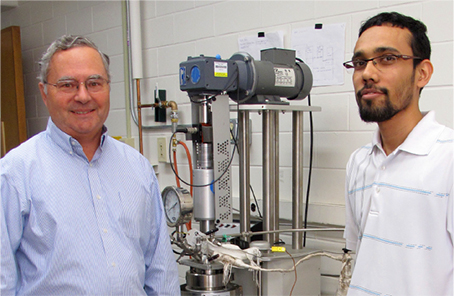
The spark
Having scaled up production by double digits, momentum builds behind new biomass process
For a world hooked on fossil carbons, the vials of amber syrup in Jim Dumesic’s lab are full of sweet potential.
Dumesic’s group caused a stir in research circles and the media in 2014 by publishing a paper in the journal Science describing a new scheme for breaking down biomass and unlocking its polysaccharides. Those sugars – candy for microbes – can be fermented to ethanol or upgraded into a host of high value chemicals currently made from petroleum.
The development of this new scheme was funded by Great Lakes Bioenergy, one of three Bioenergy Research Centers supported by the Department of Energy Office of Science.
At the crux of their method is a solvent derived from biomass itself, called gamma valerolactone (GVL). It’s an elegant process. The GVL created in the reaction is recycled and used to drive it again.
The method appears to be faster and cheaper than its competitors. It doesn’t rely on pricey enzyme cocktails that take days to work and must be tailored to the reactants.
“Our process can work in a matter of hours and on any biomass we have ever used such as corn stover, wood, leftovers from sugar cane and residues from paper mills,” says Dumesic, a professor of chemical and biological engineering.
But he knew that a process that works beautifully in 50 milliliter batches would have little practical value to a biorefinery operating on tens of tons.
With support from the WARF Accelerator Program and State of Wisconsin funding available to the Wisconsin Energy Institute, Dumesic and his team have spent the past 18 months proving their method can scale up.
Back in his office on campus, he says the funding partnershiphas been “essential to move the process ahead,” and shares the exciting results with an engineer’s sobriety.
And the results are exciting indeed. He reports that the team has bumped up production by 80-fold, with sugar yields topping 75 and 65 percent for xylose and glucose, respectively. Along the way they’ve learned to streamline steps and optimize factors like reaction temperature and acid concentration.
In addition to the sugars, they’re also producing strong streams of ‘native’ lignin that can be used for a variety of products from construction materials to paint. (‘Native’ means the lignin is not chemically altered by the process and therefore prized by researchers normally restricted to the byproducts of paper mills.)
Achieving these milestones took an unexpected collaboration.
Colleagues in the engineering department and at the Forest Products Laboratory helped Dumesic ‘cobble on’ to a reactor already in use, saving significant time and resources.
He credits the WARF Accelerator program for bringing the two camps together.
“The funding enabled us to work with the Forest Products Laboratory to modify their apparatus. Without that we never could have scaled up to the two liter level. No way.”
Now, those same colleagues are interested in taking things to the next level by designing an extruder system that operates in a continuous flow mode, like a real refinery. This would make the entire process more commercially viable – a point brought home by the Accelerator Program’s expert Catalysts.
“They tuned up our vision of where we want to take this,” says Dumesic. “That means we need a system that takes biomass, feeds it to a reactor and sends it through in a continuous process. No one has been able to do that yet.”
Dumesic, a faculty member at UW-Madison since 1976, has no illusions. He is the first to acknowledge the economic headwinds facing the biofuels movement. Cheap gasoline remains the biggest obstacle.
“If you only target biofuels you are going to lose,” he says.
His research takes a broader scope. Industrial chemicals, pharmaceuticals, polymers, even lubricants – many of these products can be made from sustainable resources and compete on price.
“Gasoline is very easy to make from petroleum. All you do is distill it. But you can make the case that other things like lubricants are harder to make from petroleum and rather easy to make from renewables,” he says. “So there is a market there.”
And Dumesic is no stranger to the private sector. With support from WARF he has helped found two startup companies in recent years, Virent Inc. and Glucan Biorenewables. He continues to serve as an advisor to the latter.
From experience, he knows that moving discoveries from the academic lab to the private sector often requires support from federal, state and local sources like WARF.
In both cases Dumesic provided the initial spark before passing the torch to younger researchers in his lab.
“It’s possible but very challenging to be a professor and stay with a startup,” he says. “Oftentimes it’s the graduate students and postdocs who want to run with it and get the technology out into the real world.”
Glucan Bio, with a location in the University Research Park in Madison, is taking the GVL method in several interesting directions. One of these relates to the production of a valuable chemical feedstock called furfural, found in agricultural formulations, herbicides and flavorants.
Furfural production has gone almost entirely to China, says Dumesic, because the process of making it is energy intensive and traditionally requires corn cobs.
“The way corn is harvested now, no one is saving the cobs,” he says. “So there is no domestic source of furfural currently available.”
Glucan Bio wants to be that source. If the technology they are developing specs out, the main importers of furfural are eager to talk.
In the meantime, Dumesic is busy teaching courses on chemical kinetics and keeping up with a dynamic biomass community stretching from Asia to the Iowa cornfields.
But he can still take a moment to reflect on the humor of his 40 years at UW-Madison.
“As part of my startup package I got an HP-45 calculator,” he smiles. “And all the figures in my thesis were drawn with India ink.”